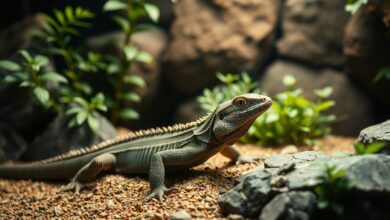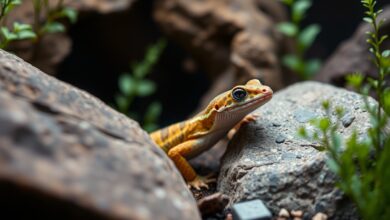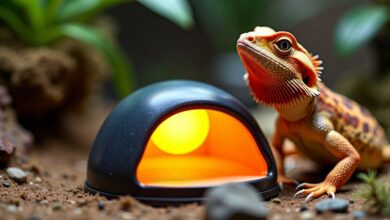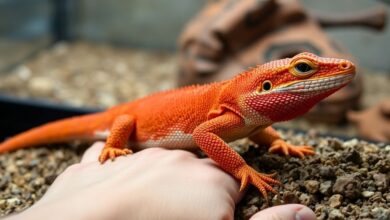5 Tips For A Translucent Pied Stripe Bearded Dragon
Caring for a Translucent Pied Stripe Bearded Dragon can be exciting and rewarding. These unique reptiles require specific care to ensure they thrive in captivity. From the right substrate to proper diet, understanding these needs is essential for any dragon owner. Here are five unique tips to help you provide the best care for your bearded dragon.
Key Takeaways
- Use safe substrates like tile or reptile carpet to avoid impaction.
- Maintain a temperature gradient in the tank with a basking spot of 95-100°F and a cooler end of 70-75°F.
- Feed a balanced diet of greens, veggies, and insects for optimal health.
- Rotate leafy greens and vegetables daily to keep meals interesting.
- Gut-load feeder insects to enhance their nutritional value before feeding.
1. Substrate

Choosing the right substrate for your Translucent Pied Stripe Bearded Dragon is crucial for their health and comfort. Here are some options:
Recommended Substrates
- Reptile Carpet: Easy to clean and safe for your dragon.
- Paper Towels: Affordable and simple to replace.
- Textured Tile: Provides a natural feel and is easy to maintain.
Substrates to Avoid
- Loose Sand: Can cause impaction if ingested.
- Tiny Pellets: Similar risks as sand.
- Unclean Organic Soil: May contain harmful chemicals.
| Substrate Type | Safety Level | Ease of Cleaning |
|---|---|---|
| Reptile Carpet | High | Easy |
| Paper Towels | High | Very Easy |
| Textured Tile | Medium | Moderate |
| Loose Sand | Low | Difficult |
| Tiny Pellets | Low | Difficult |
Tip: Always provide food in a shallow dish to prevent your dragon from ingesting substrate while eating. This simple step can help reduce the risk of impaction significantly.
By selecting the right substrate, you can create a safe and comfortable environment for your bearded dragon, ensuring they thrive in their habitat. Remember, keeping their space clean is just as important as the substrate you choose!
2. Temperature & Humidity

Ideal Temperature Ranges
Bearded dragons thrive in warm environments. The basking area should be between 95-100°F, while the cooler side should stay around 78-80°F. This temperature gradient allows your dragon to regulate its body heat effectively.
| Zone | Temperature (°F) |
|---|---|
| Basking Area | 95-100 |
| Cool Side | 78-80 |
| Nighttime | 65-70 |
Humidity Levels
Maintaining the right humidity is crucial. Aim for a humidity level of 30-40%. You can achieve this by lightly misting the enclosure or using a small humidifier. However, be cautious; too much moisture can lead to respiratory problems.
Monitoring Temperature and Humidity
To ensure your bearded dragon’s habitat is comfortable:
- Use thermometers to check temperatures in both the basking and cool areas.
- Keep a hygrometer to monitor humidity levels.
- Adjust heating lamps and misting as needed to maintain the ideal conditions.
Keeping your bearded dragon’s environment stable is key to its health and happiness. Regular checks can prevent issues before they arise.
Summary
In summary, providing the right temperature and humidity is essential for your translucent pied stripe bearded dragon. By creating a suitable habitat, you help ensure a long and healthy life for your pet.
3. Diet & Nutrition

In the wild, bearded dragons eat a variety of foods, including greens, vegetables, fruits, and insects. To keep your pet healthy, it’s important to provide a balanced diet. Here are some key points to consider:
Balanced Diet
- Greens: Offer leafy greens like collard greens, mustard greens, and kale. These should make up about 80% of their diet.
- Vegetables: Include squash, peas, and carrots. Rotate these to keep meals interesting.
- Fruits: Treat them occasionally with fruits like kiwi, banana, and mango.
Insects & Protein
- Feed insects such as crickets and mealworms 2-3 times a week. Make sure to gut-load these insects with nutritious food before feeding them to your dragon.
- Dust insects with calcium and vitamin D3 supplements to support bone health.
Supplementation
- For growing dragons, dust food with supplements 5-6 times a week. For adults, do this 2-3 times a week. This helps prevent bone disease.
A varied diet is essential for your bearded dragon’s health. Always ensure they have access to fresh water and clean food dishes.
4. Vegetables & Greens
Bearded dragons enjoy a variety of vegetables and greens in their diet. It’s important to provide them with fresh options daily to keep them healthy. Here are some great choices:
Recommended Vegetables
- Carrots
- Zucchini
- Bell Peppers
Leafy Greens
- Collard Greens
- Mustard Greens
- Kale
Serving Tips
- Chop vegetables into small pieces to make them easier to eat.
- Rotate different types of veggies to provide a balanced diet.
- Avoid iceberg lettuce as it lacks nutrients.
| Vegetable | Nutritional Benefits |
|---|---|
| Carrots | High in Vitamin A |
| Zucchini | Low in calories |
| Bell Peppers | Rich in Vitamin C |
Providing a variety of vegetables helps ensure your bearded dragon gets the nutrients they need for a healthy life.
Make sure to wash all vegetables thoroughly before serving them to your pet. This will help remove any pesticides or dirt that could be harmful. A balanced diet is key to keeping your translucent pied stripe bearded dragon happy and healthy!
5. Insects & Protein
Feeding your Translucent Pied Stripe Bearded Dragon the right insects and protein is essential for its health. A balanced diet helps them grow strong and stay active. Here are some key points to consider:
Types of Insects
- Crickets: A staple in their diet, crickets are high in protein and easy to find.
- Mealworms: These are a good source of protein but should be fed in moderation due to their high fat content.
- Roaches: Dubia roaches are nutritious and a favorite among many reptiles.
Feeding Schedule
- Young Dragons: Feed daily, offering a variety of insects.
- Adults: Feed every other day, focusing on larger insects.
- Monitor Intake: Adjust based on your dragon’s appetite and growth.
Nutritional Needs
| Nutrient | Importance |
|---|---|
| Protein | Essential for growth |
| Calcium | Important for bone health |
| Vitamins | Supports overall health |
Remember, variety is key! Offering different types of insects ensures your dragon gets all the nutrients it needs.
By following these tips, you can help your bearded dragon thrive and enjoy a healthy life. For more information on pet care, check out resources on pet street.
Final Thoughts on Caring for Your Translucent Pied Stripe Bearded Dragon
Caring for a Translucent Pied Stripe Bearded Dragon can be a rewarding experience. By following the tips we’ve shared, you can ensure your dragon stays healthy and happy. Remember to provide a safe habitat, a balanced diet, and regular handling to build a strong bond. With the right care, your bearded dragon can thrive and bring joy to your life for many years. Enjoy your journey as a dragon keeper!
Frequently Asked Questions
Are bearded dragons easy to care for?
Yes, with the right setup and care, bearded dragons are manageable for both beginners and experienced owners. They have friendly personalities and straightforward needs.
How should beginners take care of a bearded dragon?
Focus on setting up the tank properly, feeding a mix of insects and vegetables, providing heat and UVB light, handling them regularly, and keeping their space clean.
Do bearded dragons need daily handling?
Not necessarily. While daily handling isn’t required, regular gentle interactions help them feel comfortable and bond with you.
How often should I give my bearded dragon a bath?
Aim for baths once or twice a week. The water should be shallow and warm to help with hydration and shedding.
What signs show my bearded dragon is comfortable with me?
If your dragon watches TV with you, sleeps on you, comes out of its enclosure willingly, and recognizes your voice, it means they are comfortable.
How can I keep my bearded dragon healthy?
Regular vet checkups, a balanced diet, proper heating and lighting, and a clean living environment are key to keeping your bearded dragon healthy.





